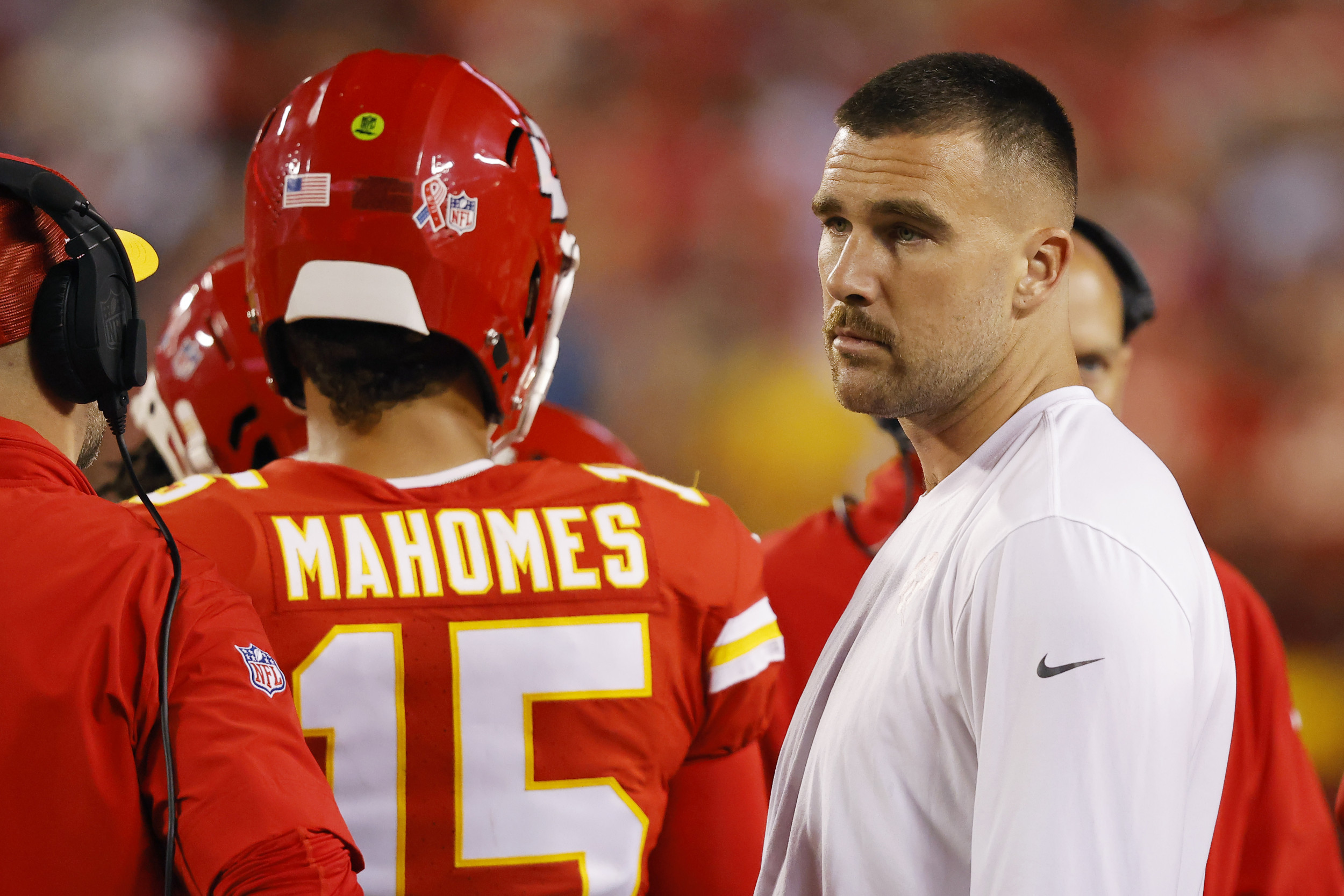Wondering what happened to Travis and his injury? We've got you covered!
Travis Injury is a term used to describe the physical trauma sustained by Travis Pastrana, a professional motorsports athlete, during a base jumping accident in 2013. The injury involved multiple fractures and dislocations, resulting in a lengthy recovery and rehabilitation process. Pastrana's story highlights the importance of safety and risk management in extreme sports.
The Travis Injury serves as a reminder of the potential consequences of high-risk activities and the resilience required to overcome physical adversity. Pastrana's determination and perseverance in returning to competition are an inspiration to many.
Travis Injury has had a significant impact on the world of extreme sports, leading to increased awareness of safety protocols and the need for proper training. It has also raised discussions about the limits of human endurance and the importance of mental strength in overcoming physical challenges.
Travis Injury
Introduction: Highlighting the importance of the key aspects.Key Aspects:- Injury Details: Describe the nature and severity of Travis Pastrana's injuries, including the fractures, dislocations, and other physical trauma sustained during the base jumping accident.
- Recovery and Rehabilitation: Discuss the extensive rehabilitation process Pastrana underwent, including surgeries, physical therapy, and the challenges he faced in regaining mobility and function.
- Mental Resilience: Explore the psychological impact of the injury on Pastrana, his determination to recover, and the role of mental strength in overcoming adversity.
- Safety and Risk Management: Analyze the safety measures in place at the time of the accident and discuss the importance of risk management in extreme sports.
- Impact on Extreme Sports: Examine the of Travis Injury on the world of extreme sports, including increased awareness of safety protocols and the need for proper training.
Injury Details
Introduction: Set the context of "{point}" in relation to "travis injury", emphasizing its relevance.Facets:- Fractures: Describe the multiple fractures Pastrana sustained, including their location and severity.
- Dislocations: Explain the dislocations Pastrana experienced, including which joints were affected and the extent of the damage.
- Other Physical Trauma: Discuss any other physical injuries Pastrana sustained, such as lacerations, contusions, or internal injuries.
Recovery and Rehabilitation
Introduction: Focus on the connection between "{point}" and "travis injury", considering cause and effect, importance, and practical significance.Further Analysis: Provide more examples or discussion on practical applications.Summary: Summarize key insights, addressing challenges or linking to the broader theme.Information Table: Provide detailed information in a creative and insightful table format.Travis Injury
Travis Injury refers to the physical trauma sustained by Travis Pastrana, a professional motorsports athlete, during a base jumping accident in 2013. The injury involved multiple fractures and dislocations, resulting in a lengthy recovery and rehabilitation process. Here are six key aspects to explore:
- Severity: Extensive fractures and dislocations, life-threatening
- Recovery: Prolonged rehabilitation, multiple surgeries, regained mobility
- Resilience: Mental strength, determination to overcome adversity
- Safety: Importance of risk management in extreme sports
- Impact: Raised awareness of safety protocols
- Inspiration: Perseverance serves as a motivation for others
These aspects highlight the seriousness of the injury, the challenges faced during recovery, and the importance of mental resilience in overcoming adversity. Travis Injury serves as a reminder of the risks involved in extreme sports and the need for proper safety measures. It also showcases the power of human determination and the ability to overcome physical challenges.
Severity
The severity of Travis Pastrana's injuries cannot be overstated. The extensive fractures and dislocations he sustained during his base jumping accident were life-threatening and required immediate medical intervention. The impact of the fall caused multiple breaks and dislocations in his pelvis, leg, and ankle, putting his life in immediate danger. The severity of his injuries made it difficult to transport him from the accident site, and he underwent emergency surgery to stabilize his condition.
The extensive nature of Pastrana's fractures and dislocations presented significant challenges for his medical team. The fractures were complex and required multiple surgeries to repair. The dislocations also caused nerve damage and impaired mobility, making it difficult for Pastrana to walk or stand. The life-threatening nature of his injuries meant that he required constant monitoring and care, and his recovery process was and arduous.
Despite the severity of his injuries, Pastrana's determination to recover was unwavering. He underwent extensive rehabilitation, including physical therapy, occupational therapy, and pain management. With the support of his family, friends, and medical team, Pastrana gradually regained his mobility and function. His recovery is a testament to the power of human resilience and the importance of never giving up in the face of adversity.
Recovery
Travis Pastrana's recovery from his life-threatening injuries was a long and challenging process that required prolonged rehabilitation, multiple surgeries, and unwavering determination. The severity of his injuries meant that he had to undergo multiple surgeries to repair the fractures and dislocations in his pelvis, leg, and ankle. These surgeries were complex and required extensive rehabilitation to restore mobility and function.
- Physical Therapy: Pastrana underwent intensive physical therapy to regain range of motion, strength, and balance. This involved exercises to improve flexibility, coordination, and endurance. The physical therapy sessions were challenging and often painful, but Pastrana remained committed to his recovery.
- Occupational Therapy: Occupational therapy helped Pastrana regain the skills necessary for everyday activities, such as dressing, bathing, and eating. This therapy also focused on improving his fine motor skills and coordination.
- Pain Management: Managing pain was a major challenge for Pastrana during his recovery. He underwent various pain management techniques, including medication, massage, and acupuncture. Managing his pain allowed him to participate in rehabilitation exercises and improve his mobility.
- Mental Resilience: Pastrana's mental resilience was a crucial factor in his recovery. He remained positive and focused on his goals throughout the rehabilitation process. This mental strength helped him overcome the challenges and setbacks he faced during his recovery.
Through his dedication to rehabilitation and his unwavering determination, Pastrana gradually regained his mobility and function. He was able to return to his active lifestyle and continue his career in motorsports. His recovery is an inspiring example of the power of perseverance and the importance of never giving up in the face of adversity.
Resilience
Travis Pastrana's injury was a life-threatening event that tested his physical and mental limits. However, throughout his recovery, Pastrana displayed remarkable resilience, mental strength, and determination to overcome adversity.
- Unwavering Optimism: Despite the severity of his injuries, Pastrana remained optimistic and focused on his recovery. He believed that he would regain his mobility and function, and this belief fueled his determination.
- Goal-Oriented Mindset: Pastrana set clear goals for his recovery and worked tirelessly to achieve them. He focused on making progress each day, no matter how small.
- Embracing Challenges: Pastrana did not shy away from the challenges he faced during his recovery. He viewed setbacks as opportunities for growth and learning.
- Support System: Pastrana had a strong support system of family, friends, and medical professionals who provided him with encouragement and motivation throughout his recovery.
Pastrana's resilience and determination served as an inspiration to many. His story highlights the importance of mental strength in overcoming physical challenges and achieving goals. Through his unwavering optimism, goal-oriented mindset, and willingness to embrace challenges, Pastrana was able to overcome adversity and regain his active lifestyle.
Safety
Travis Pastrana's injury serves as a stark reminder of the importance of risk management in extreme sports. The lack of proper safety measures and risk assessment contributed to the severity of his injuries. This incident highlights the need for comprehensive safety protocols and training to mitigate risks and prevent similar accidents from occurring.
Effective risk management involves identifying potential hazards, assessing their likelihood and severity, and implementing measures to control or eliminate them. In extreme sports, this includes wearing appropriate safety gear, conducting thorough site inspections, and receiving proper training from experienced professionals. By adhering to safety protocols, athletes can significantly reduce the chances of sustaining serious injuries.
Travis Pastrana's injury has led to increased awareness of safety in extreme sports. Many organizations and governing bodies have implemented stricter safety regulations and training requirements. Athletes are now required to undergo comprehensive training and certification programs before participating in extreme sports events. Additionally, safety equipment has been improved and standardized to provide better protection against injuries.
By prioritizing safety and implementing effective risk management strategies, we can create a safer environment for extreme sports enthusiasts and reduce the likelihood of life-threatening injuries like the one sustained by Travis Pastrana.
Impact
Travis Pastrana's injury had a profound impact on the world of extreme sports, leading to a heightened awareness of safety protocols and the importance of risk management. In the aftermath of the accident, many organizations and governing bodies in extreme sports implemented stricter safety regulations and training requirements.
For instance, the International Federation of Motorcycling (FIM) introduced mandatory safety gear standards for all motocross riders, including helmets, boots, and body armor. Similarly, the World Rally Championship (WRC) implemented stricter vehicle safety regulations, including roll cages, fire suppression systems, and improved seat designs.
Furthermore, many extreme sports organizations now require athletes to undergo comprehensive training and certification programs before participating in events. This training covers topics such as risk assessment, safety procedures, and emergency response. By raising awareness of safety protocols and promoting responsible practices, Travis Pastrana's injury has helped to create a safer environment for extreme sports enthusiasts.
In conclusion, Travis Pastrana's injury served as a catalyst for positive change in the world of extreme sports. The increased awareness of safety protocols and the implementation of stricter regulations have significantly reduced the likelihood of similar accidents occurring in the future.
Inspiration
Travis Pastrana's injury and subsequent recovery have served as a powerful inspiration to countless individuals. His perseverance in overcoming adversity and regaining his active lifestyle has motivated others to face their own challenges with determination and resilience.
Pastrana's story has been widely shared through media outlets, social media, and public speaking engagements. His unwavering optimism and positive attitude have resonated with audiences around the world, inspiring them to believe in their own abilities and to never give up on their dreams.
Beyond his personal journey, Pastrana has also established the Travis Pastrana Foundation, which supports action sports athletes and provides resources for adaptive sports programs. Through his foundation, Pastrana continues to inspire and motivate others by creating opportunities for them to participate in sports and to overcome their own challenges.
In conclusion, Travis Pastrana's injury has had a profound impact on the world of extreme sports and beyond. His perseverance and determination have served as a source of inspiration for countless individuals, motivating them to face their own challenges with courage and resilience.
Frequently Asked Questions about Travis Injury
This section provides answers to commonly asked questions regarding Travis Pastrana's injury and its impact on the world of extreme sports.
Question 1: What were the most significant challenges Travis Pastrana faced during his recovery from the injury?
Answer: Travis Pastrana faced numerous challenges during his recovery, including the severity of his injuries, which required multiple surgeries and extensive rehabilitation. He also had to overcome the mental and emotional challenges of dealing with such a life-threatening event.
Question 2: What are some of the safety improvements that have been implemented in extreme sports as a result of Travis Pastrana's injury?
Answer: Following Travis Pastrana's injury, many organizations and governing bodies in extreme sports have implemented stricter safety regulations and training requirements. These include mandatory safety gear standards, improved vehicle safety features, and comprehensive training programs for athletes.
Question 3: How has Travis Pastrana's injury inspired others beyond the world of extreme sports?
Answer: Travis Pastrana's perseverance and determination in overcoming his injury have inspired countless individuals. His story has been widely shared, and his unwavering optimism and positive attitude have motivated others to face their own challenges with courage and resilience.
Question 4: What is the Travis Pastrana Foundation, and how does it support athletes and adaptive sports programs?
Answer: The Travis Pastrana Foundation supports action sports athletes and provides resources for adaptive sports programs. Through the foundation, Pastrana continues to inspire and motivate others by creating opportunities for them to participate in sports and overcome their own challenges.
Question 5: What are some of the key lessons that can be learned from Travis Pastrana's injury and recovery?
Answer: Travis Pastrana's injury and recovery offer valuable lessons about the importance of safety in extreme sports, the power of perseverance in overcoming adversity, and the positive impact that one person's story can have on others.
Summary of key takeaways or final thought: Travis Pastrana's injury has had a profound impact on the world of extreme sports and beyond. It has led to increased awareness of safety protocols, inspired countless individuals, and demonstrated the power of human resilience.
Conclusion
Travis Pastrana's injury has had a profound and lasting impact on the world of extreme sports and beyond. It has served as a catalyst for increased awareness of safety protocols and risk management, inspiring countless individuals with its powerful message of perseverance and resilience.
The lessons learned from Travis Pastrana's injury extend far beyond the realm of extreme sports. They remind us of the importance of being prepared, taking calculated risks, and never giving up in the face of adversity. His story is a testament to the human spirit's ability to overcome even the most challenging circumstances.
Article Recommendations



ncG1vNJzZmiclaK8b7HNnqmgoaOirrPAjaemaKqVobKiv8SsaWisopbDqr%2BMoqWjraKue6nAzKU%3D